AGRICULTURAL SCIENCES PAPER 1 GRADE 12 QUESTIONS - NSC EXAMS PAST PAPERS AND MEMOS SEPTEMBER 2019 PREPARATORY EXAMINATIONS
Share via Whatsapp Join our WhatsApp Group Join our Telegram GroupAGRICULTURAL SCIENCES
PAPER 1
GRADE 12
NSC EXAMS PAST PAPERS AND MEMOS SEPTEMBER 2019
PREPARATORY EXAMINATIONS
INSTRUCTIONS AND INFORMATION
- This question paper consists of TWO sections, namely SECTION A and SECTION B.
- Answer ALL the questions in the ANSWER BOOK.
- Start EACH question on a NEW page.
- Number the answers correctly according to the numbering system used in this question paper.
- You may use a non-programmable calculator.
- Show ALL calculations, including formulae, where applicable.
- Write neatly and legibly.
QUESTIONS
SECTION A
QUESTION 1
1.1 Various options are provided as possible answers to the following questions. Choose the answer and write only the letter (A–D) next to the question numbers (1.1.1–1.1.10) in the ANSWER BOOK, e.g. 1.1.11 B.
1.1.1 The presence of … is an adaptation feature of the rumen to perform its functions. .
- villi
- bacteria
- hardware
- fermenter
1.1.2 The hydrochloric acid in the stomach changes …
- fructose into sucrose.
- galactose into lactose.
- pepsinogen to pepsin.
- pH into an alkaline medium.
1.1.3 The digestibility co-efficiency of 72% implies that …
- 72% of feed is excreted.
- 72% of feed is available for maintenance and growth.
- 28% of feed was digested and egested.
- 28% of feed can be used by an animal for production and reproduction.
1.1.4 During regurgitation in ruminants the following occurs:
- Walls of the reticulum contracts and bolus enters the oesophagus
- Fine food passes back into the mouth by retroperistalsis
- Bolus of partly digested coarse feed moves back to the mouth
- The process involves re-mastication to increase the surface area
Choose the CORRECT combination:
- (i), (iii) and (iv)
- (ii), (iii) and (iv)
- (i), (ii) and (iii)
- (i), (ii) and (iv)
1.1.5 The equipment in the picture below is used by farmers for … . 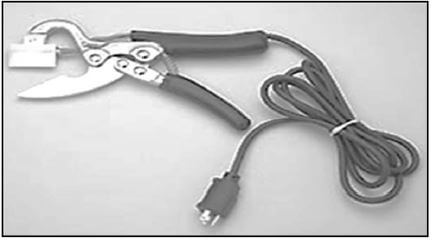
- clamping.
- tagging.
- branding.
- docking.
1.1.6 The purpose of vaccination is mainly to … the occurrence of diseases in farm animals.
- prevent
- control
- increase
- prolong
1.1.7 The best way to prevent infestation of liver fluke on a farm.
- Regular dipping.
- Destroying slugs and snails.
- Shear animals before the rainy season.
- Quarantine all infected animals.
1.1.8 The safest way to approach an animal during handling is …
- to announce your presence through a touch on the side or front.
- never prod the animal if it has no space to go.
- to move the animal through a chute that has minimal obstruction.
- move from its blind spot.
Choose the CORRECT combination:
- (i), (iii) and (iv)
- (ii), (iii) and (iv)
- (i), (ii) and (iii)
- (i), (ii) and (iv)
1.1.9 The following occurs during the process of spermatogenesis:
- Secondary spermatocytes divide mitotically to form spermatids
- Spermatogonium divides by meiosis to form primary spermatocytes
- Primary spermatocytes are transformed into two secondary spermatocytes during meiosis
- Spermatids undergo morphological changes to form oocytes
1.1.10 The hormone that may inhibit the milk ejection reflex.
- Oxytocin
- Luteotrophic
- Prolactin
- Adrenalin (10 x 2) (20)
1.2 Indicate whether each of the descriptions in COLUMN B applies to A ONLY, B ONLY, BOTH A AND B or NONE of the items in COLUMN A. Write A only, B only, both A and B or none, next to the question numbers (1.2.1–1.2.5) in the ANSWER BOOK, e.g. 1.2.6 B only.
COLUMN A | COLUMN B | ||
1.2.1 | A: | Islets of Lieberkühn | Found in the pancreas and secretes the hormone that promote movement of glucose out of the blood to the cells |
B: | Islets of Langerhans | ||
1.2.2 | A: | Bile | Counteracts food rotting in the alimentary canal |
B: | Hydrochloric acid | ||
1.2.3 | A: | Infra-red light | Equipment in an extensive beef production system used to reduce the impact of cold conditions |
B: | Insulator | ||
1.2.4 | A: | Metabolic | Diseases caused by nutritional deficiencies in animal feed |
B: | Endemic | ||
1.2.5 | A | Sterility | Abnormalities of the acrosomal head and tail resulting in an immotile sperm cell |
B: | Infertility | ||
(5 x 2) (10)
1.3 Give ONE word/term for each of the following descriptions. Write only the word/term next to the question numbers (1.3.1–1.3.5) in the ANSWER BOOK.
1.3.1 The measure/index indicating the quality of protein in a feed
1.3.2 An apparatus used to apply liquid medication to an animal to control internal parasites
1.3.3 The condition where a cow needs to mate three or more times before it conceives
1.3.4 A single two lobed gland surrounding the urethra that secretes a liquid giving semen its characteristic smell
1.3.5 The accumulation of liquid in and around the brain of a foetus causing a difficult birth (5 x 2) (10)
1.4 Change the UNDERLINED WORD(S) in EACH of the following statements to make it TRUE. Write only the answer next to the question numbers (1.4.1–1.4.5) in the ANSWER BOOK.
1.4.1 A ration that provides all the required nutrients for the basic functioning of farm animals, is an ideal ration.
1.4.2 An intensive production system where a group of chickens remain in a chicken house until they have stopped laying eggs, is a deep-litter system.
1.4.3 Superfetation is the release of a large number of ova from one female during the same oestrus cycle.
1.4.4 Tail is the part of the sperm cell that facilitates penetration into the zona pellucida.
1.4.5 Parturition is the stage in dairy cows that occurs between two lactations. (5 x 1) (5)
TOTAL SECTION A: 45
SECTION B
QUESTION 2: ANIMAL NUTRITION
Start this question on a NEW page.
2.1 The diagrams below represent alimentary canals of farm animals. 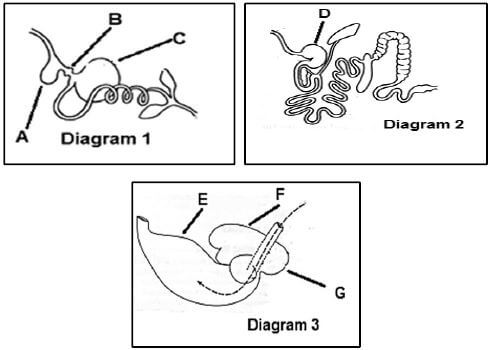
2.1.1 Classify the animals with an alimentary canal represented by Diagram 1 and Diagram 3. (2)
2.1.2 Provide the reason for each of the answers in QUESTION 2.1.1. (2)
2.1.3 Determine the age of the animal with the alimentary canal shown in Diagram 3. (1)
2.1.4 Give ONE reason visible in the diagram to support your answer in QUESTION 2.1.3. (1)
2.1.5 Animals with alimentary canals as in Diagram 2 and Diagram 3 cannot digest feed with a high crude fibre content. Justify this statement by giving ONE reason for each animal. (2)
2.1.6 Identify the letter in Diagram 1 and Diagram 3 representing the part where rennin is secreted. (2)
2.2 Below are different feeds used to feed farm animals.
Oil cake meal, green lucerne, sun dried hay, maize meal, urea |
Indicate the feed from the box above that is applicable to each of the following statements:
- A source of protein for newly born lambs (1)
- Recommended for fattening animals (1)
- A feed rich in vitamin D (1)
- A roughage that is a source of vitamin A (1)
2.3 The table below shows the composition of TWO animal feeds.
FEED COMPONENT | FEED A(%) | FEED B (%) |
Digestible protein | 12,5 | 6,25 |
Crude fibre | 6 | 14,2 |
Nitrogen-free extract | 60 | 40 |
Fat | 1,5 | 2 |
2.3.1 Classify FEED A and FEED B from the table above. (2)
2.3.2 Refer to the table above and give a reason for each feed classified in QUESTION 2.3.1. (2)
2.3.3 Calculate the nutritive ratio of FEED A. (4)
2.3.4 Recommend with a reason, the purpose for which FEED A can be used based on its nutritive ratio. (2)
2.4 The diagram below shows the process occurring in the alimentary canal after digestion. 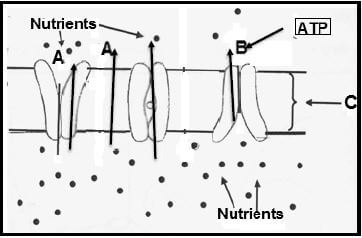
2.4.1 Identify the process illustrated above. (1)
2.4.2 Name the part of the alimentary canal where the process illustrated above occurs, (1)
2.4.3 Identify the type of nutrient transport shown by arrows A and B. (2)
2.4.4 Provide a reason for your answer in QUESTION 2.4.3. (2)
2.5 The table below shows the feed available and supplementary feed requirement in a sheep production unit over a period of six months.
MONTHS | 1 | 2 | 3 | 4 | 5 | 6 |
Feed available (kg/ha) | 1 200 | 800 | 200 | 100 | 80 | 50 |
Supplementary requirement (kg/animal/day) | ____ | ____ | 2 | 3 | 4 | 6 |
2.5.1 Identify the month in which it will be advisable for the farmer to cull the sheep. (1)
2.5.2 Give a reason from the data to support your answer in QUESTION 2.5.1. (1)
2.5.3 Calculate the amount of feed available in tons during month 2 if the farm has 14 hectares available for grazing. (3) [35]
QUESTION 3: ANIMAL PRODUCTION, PROTECTION AND CONTROL
Start this question on a NEW page.
3.1 The bar graph below shows the temperature requirements of broiler chickens over a period of seven weeks. 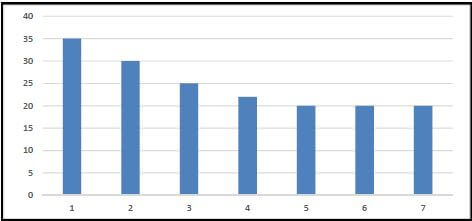
3.1.1 Deduce from the graph the trend of temperature requirement for broilers. (2)
3.1.2 Translate the information above from the first to sixth week into a line graph. (6)
3.1.3 Name the equipment that can be used in a broiler house if the temperature drops below 10 °C. (1)
3.2 Animals behave differently when they are subjected to stress. The picture below shows a bull under stress. 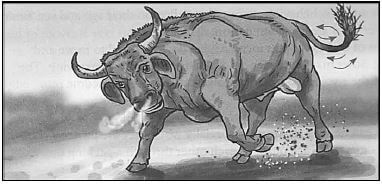
3.2.1 Identify THREE visible signs showing that the bull is in distress. (3)
3.2.2 Indicate the effect of the behaviour of the bull above to handlers and other animals. (1)
3.2.3 Name the equipment the handler can use to move the animal in the picture above when it is in a crush. (1)
3.2.4 Suggest THREE guidelines for handling large farm animals to prevent the behaviour in the picture above. (3)
3.3 Below is a picture of a production unit for keeping farm animals. 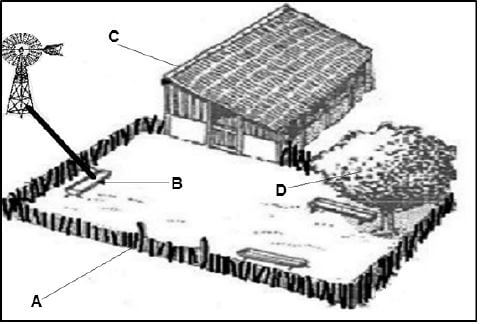
3.3.1 Identify the production system above. (1)
3.3.2 Give ONE reason to support the answer in QUESTION 3.3.1. (1)
3.3.3 Identify the letter from the picture where the following occurs:
- Can be used to prevent the effect of extreme temperatures (1)
- Prevent dehydration in animals (1)
- Provide shade during the day (1)
FOOT-AND-MOUTH DISEASE/FMD The disease is highly contagious and as a result some countries impose strict trade regulations on imported animal products to prevent the introduction of the disease. If an outbreak occurs, veterinary services enforce quarantine and slaughter the affected animals to eradicate the disease. |
3.4
3.4.1 Name the pathogen responsible for the disease. (1)
3.4.2 Extract from the scenario the term which means that FMD can be transferred to other animals. (1)
3.4.3 Indicate ONE key symptom that farmers can observe when an animal has FMD. (1)
3.4.4 Deduce from the scenario TWO roles of the state to control FMD. (2)
3.5 Below is a list of parasites that affect livestock.
Tape worm, bont tick, liver fluke, blue tick, nasal worm, blowfly |
Choose the parasite from the list to which each of the statements below applies:
- Causes irritation of the sinuses and sneezing (1)
- It needs a snail within a day to stay alive (1)
- Transmits heart water in sheep (1)
- Proglottids appear in the faeces of the infected animal (1)
- Crouching can minimise the infestation (1)
3.6 State THREE basic principles of good health to control animal diseases and parasites on a farm. (3) [35]
QUESTION 4: ANIMAL REPRODUCTION
Start this question on a NEW page.
4.1 The diagrams below show the organs in the reproductive system of a bull and a cow. 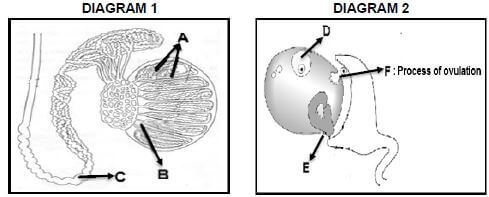
4.1.1 Identify the letter representing the part where the following occurs in Diagram 1 and Diagram 2:
- Gametes are formed in Diagram 1 and Diagram 2 (2)
- Acts as a temperature control mechanism in Diagram 1 (1)
- Secretion of progesterone in Diagram 2 (1)
- Production of testosterone in Diagram 1 (1)
4.1.2 Name the congenital defect common in both organs in the diagrams above that may lead to sterility. (1)
4.1.3 Indicate TWO hormones responsible for the process labelled F. (2)
4.2 Name TWO senses that are important in regulating mating behaviour in bulls. (2)
4.3
Artificial insemination is one of the important processes performed in female animals to increase the herd economically and rapidly. |
Below are the steps that are involved before and during artificial insemination to ensure successful conception:
- Semen dilution
- Placing semen into the reproductive tract of a cow
- Semen examination
- Heat detection
- Semen harvesting
4.3.1 Re-arrange the steps above in chronological order to ensure successful artificial insemination. (5)
4.3.2 State TWO economic benefits of artificial insemination for a farmer. (2)
4.4 The diagram below illustrates the reproductive process that occurs in farm animals. 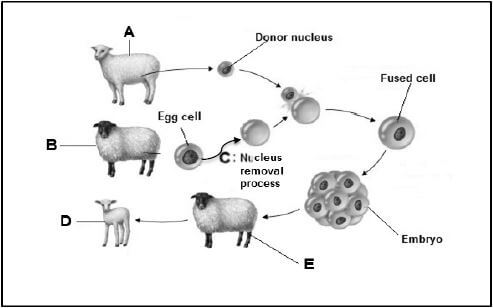
4.4.1 Identify the process illustrated above. (1)
4.4.2 Indicate the letter representing the sheep that will be genetically identical to the sheep labelled D. (1)
4.4.3 Write the letter of the sheep that will serve as a surrogate. (1)
4.4.4 Give the name of the process labelled C. (1)
4.4.5 Name TWO aims of the process illustrated above. (2)
4.5 The flow chart below shows the stages during gestation. 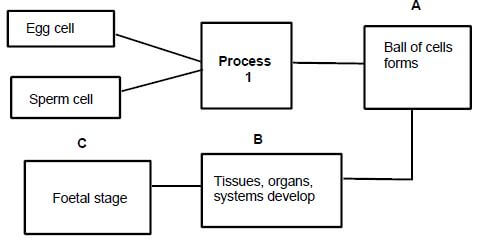
4.5.1 Identify the process in 1. (1)
4.5.2 Give the stage of pregnancy labelled A. (1)
4.5.3 Indicate the development that occurs in stage C. (1)
4.5.4 Name TWO systems that develop from the endoderm at stage B. (2)
4.5.5 A cow may not carry the foetus up to birth. Give TWO reasons for this. (2)
4.6 Parturition is a complicated process and can be problematic especially if presentation of the calf is not correct.
4.6.1 Give the form of presentation represented by each of the statements below:
- Foetus lies on its abdomen with forefeet stretching towards the pelvis and the head is resting on it (1)
- Rear part of the foetus lies towards the cervix resulting in the hind legs appearing first (1)
4.6.2 Indicate the presentation that will need the assistance of a veterinarian. (1)
4.6.3 Name TWO problems other than presentation that may cause difficult births. (2) [35]
TOTAL SECTION B: 105
GRAND TOTAL: 150